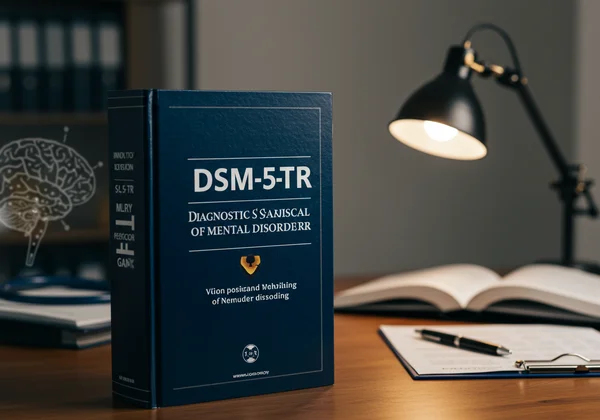Am I a Narcissist? Take Our Free NPD Test: Understanding the DSM-5 TR Criteria
As a psychology enthusiast, I’ve always been fascinated by the complexities of the human personality. The term "narcissist" is used frequently in popular culture, often to describe anyone who seems overly confident or posts too many selfies. But what does it really mean from a clinical perspective? If you’re a Self-Doubting Explorer questioning your own traits, a Concerned Partner trying to understand a difficult relationship, or a fellow student of psychology, clarity begins with the official source. What are the 9 signs of NPD? This guide will walk you through the official diagnostic criteria for Narcissistic Personality Disorder (NPD) as defined in the Diagnostic and Statistical Manual of Mental Disorders, Fifth Edition, Text Revision (DSM-5-TR). Understanding these criteria is the first step toward genuine insight. If these points resonate with you, you can explore your traits with our confidential test.
What is Narcissistic Personality Disorder (NPD)?
Before we dive into the specific symptoms, it’s crucial to understand what we're discussing. NPD is a formal mental health condition, not just a personality quirk. It is characterized by a persistent pattern of grandiosity, a continuous need for admiration, and a profound lack of empathy for others. This pattern begins by early adulthood and is present in various contexts, causing significant distress or impairment in social, occupational, or other important areas of functioning.
Defining NPD: Beyond Surface-Level Traits
It's easy to mistake arrogance for NPD, but the disorder is far more complex. It's not about healthy self-esteem; it's about a fragile sense of self that relies on external validation to feel stable. This creates a deep-seated need to maintain an image of superiority, often at the expense of others. The inflated ego often masks deep insecurities and an inability to handle criticism, which can lead to significant interpersonal turmoil and personal suffering.

Why the DSM-5 TR Matters for Official NPD Signs
When we talk about the official NPD signs, we are referring to the criteria established by mental health professionals and published in the DSM-5-TR. This manual is the authoritative guide used by clinicians in the United States and much of the world to diagnose mental disorders. Relying on these clinical standards ensures that our understanding is based on scientific research and clinical consensus, not on stereotypes or misinformation. This framework helps differentiate a diagnosable disorder from common narcissistic traits that many people may exhibit from time to time.

The 9 DSM-5 TR Criteria for Narcissistic Personality Disorder Symptoms Explained
For a clinical diagnosis of NPD, an individual must exhibit a pervasive pattern of at least five of the following nine criteria. Let's explore each one with a clear explanation and a real-world example.
1. Grandiose Sense of Self-Importance
This goes beyond simple confidence. It involves a consistent overestimation of one's abilities and exaggerated achievements. An individual with this trait often expects to be recognized as superior without commensurate accomplishments.
- Example: A junior employee consistently talks about their ideas as "revolutionary" and implies they are single-handedly responsible for the team's success, even when their contribution was minor.
2. Preoccupation with Fantasies of Unlimited Success, Power, Brilliance, Beauty, or Ideal Love
Individuals with NPD often live in a fantasy world that supports their delusions of grandeur. They are preoccupied with unrealistic ambitions and spend significant time thinking about achieving immense power, attracting the perfect partner, or gaining widespread acclaim.
- Example: Someone who is financially unstable might spend hours detailing their future as a tech billionaire, focusing more on the fantasy than on taking practical steps to improve their situation.
3. Belief They Are "Special" and Unique
This trait involves a core belief that one is exceptional and can only be understood by, or should associate with, other special or high-status people or institutions. There is a profound sense of uniqueness that sets them apart from everyone else.
- Example: A person might refuse to see a perfectly competent local doctor, insisting they can only be treated by the "top specialist in the country," whom they believe is the only one capable of understanding their "complex" case.
4. Requirement for Excessive Admiration
This is a critical trait. The individual has a strong need for validation and requires constant attention and praise from others. Their self-esteem is like a leaky bucket, needing to be constantly refilled with admiration.
- Example: After giving a presentation, a colleague might repeatedly ask, "What did you think? Wasn't that brilliant?" and become visibly annoyed or dejected if the praise is not effusive enough. This is a common indicator you can explore with an NPD screening tool.
5. Sense of Entitlement
This manifests as unreasonable expectations of especially favorable treatment or automatic compliance with their expectations. They believe they deserve special treatment and that the rules don't apply to them.
- Example: A customer who demands a full refund for a product they have used for months, believing their dissatisfaction alone entitles them to bypass the store's clear return policy.
6. Interpersonally Exploitative Behavior
This involves taking advantage of others to achieve one's own ends. Relationships are often viewed in terms of their usefulness, and there is little hesitation in using manipulation to get what they want.
- Example: A friend who consistently borrows money with no intention of paying it back, using emotional stories to gain sympathy and financial support.
7. Lack of Empathy
Perhaps the most damaging trait, this is the inability or unwillingness to recognize or identify with the feelings and needs of others. The emotional detachment from others' pain is a hallmark of the disorder.
- Example: When a friend is sharing a painful story about a breakup, the individual might interrupt to talk about their own minor inconvenience, showing no genuine interest or concern for their friend's distress.
8. Envy of Others or Belief That Others Are Envious of Them
This involves a persistent sense of jealousy toward others' successes or possessions. Conversely, they may believe that others are deeply envious of them, their talents, and their life, even when there is no evidence for it.
- Example: An individual might belittle a coworker's promotion, attributing it to "luck" or "office politics" rather than merit, while simultaneously believing their colleagues are secretly jealous of their own "superior" intellect.
9. Arrogant, Haughty Behaviors or Attitudes
This trait is characterized by a condescending demeanor and a patronizing attitude. They often treat others as if they are inferior, which can manifest in snide remarks, dismissive gestures, or an air of contempt.
- Example: A person at a dinner party who scoffs at another guest's opinion, rolling their eyes and saying, "Well, I suppose that's one way to look at it if you haven't really thought it through."
Beyond Clinical Definitions: Real-World Manifestations of NPD Traits
It is essential to remember that these clinical criteria are just one piece of the puzzle. How these traits appear in everyday life can vary significantly from person to person.
The Spectrum of Narcissistic Expressions
Narcissism exists on a spectrum. While some individuals may meet the full criteria for a clinical diagnosis of NPD, many others may exhibit several traits without having the full-blown disorder. These traits can still cause significant relational conflict and personal distress. Understanding this spectrum is key to approaching the topic with nuance and empathy. Recognizing where certain behaviors fall on this spectrum is the first step toward getting valuable insights.

How These Traits Impact Relationships and Daily Life
The consequences of these behaviors are often profound. For the individual, it can lead to a cycle of broken relationships, professional setbacks, and a deep-seated feeling of dissatisfaction. For those around them—partners, family members, and colleagues—it can be an experience filled with confusion, emotional pain, and self-doubt. Recognizing these patterns is not about labeling, but about understanding the dynamics at play to protect one's own mental well-being.
Your Path to Deeper Understanding: Taking the Next Step
Learning about the nine DSM-5-TR criteria for NPD provides a solid, authoritative foundation for understanding this complex personality structure. It moves the conversation from casual labels to clinical realities. Whether you see these traits in yourself or someone you know, this knowledge is a powerful tool for clarity.
If this exploration has sparked questions, the next logical step is to explore them in a safe, private setting. A well-designed npd test based on these principles can serve as a valuable screening tool. It can provide a starting point for self-reflection and help you decide if seeking professional guidance is the right path for you. Ready to gain personal insight? Start your confidential test now.

Frequently Asked Questions About NPD Criteria & Assessment
What is an NPD test, and how does it relate to DSM-5 TR criteria?
An NPD test is a screening questionnaire designed to identify the presence and severity of narcissistic traits. Reputable tests, like the free NPD test offered here, are developed using questions that reflect the nine official DSM-5 TR criteria. It is a confidential, preliminary tool to help you gain insight, not a formal diagnosis.
How do these 9 signs differ from general self-confidence?
Healthy self-confidence is based on realistic self-appraisal and genuine accomplishments. It doesn't require constant external validation and is compatible with empathy. The nine signs of NPD, in contrast, describe a pattern of grandiosity that is often unfounded, a desperate need for admiration, and a fundamental inability to connect with the feelings of others.
Can someone exhibit these traits without having NPD?
Absolutely. Most people will exhibit one or more of these traits at some point in their lives, especially under stress. A diagnosis of NPD requires a pervasive, long-term pattern of at least five of the nine criteria that significantly impairs an individual's life. Our free npd test can help you explore where you might fall on this spectrum.
Do narcissists know they have these traits or NPD?
This is a complex question. Many individuals with NPD have limited self-awareness (anosognosia) and do not see their behaviors as problematic. They may genuinely believe in their superiority and view any issues as the fault of others. However, some, particularly those who experience significant life consequences, may become aware that their patterns are destructive and seek help.
What should I do if I recognize these traits in myself or someone else?
If you recognize these traits in yourself, taking a confidential test for npd can be an excellent first step for self-reflection. If the results are concerning, or if you are struggling, seeking therapy from a qualified mental health professional is highly recommended. If you recognize these traits in someone else, it's important to set healthy boundaries to protect your own well-being and encourage them to seek professional help if it feels safe and appropriate to do so.